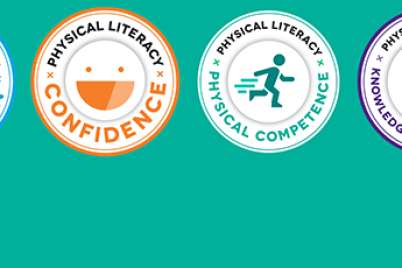
How grandparents can share physical literacy with grandkids
With professional childcare often in short supply, some of today’s grandparents find themselves providing care for their grandchildren.
As luck would have it, this offers a special opportunity for grandparents and grandkids alike. Both can benefit from enhanced physical literacy if they use their time together to play.
Physical literacy can be summarized briefly as the skills, confidence, and love of movement to be active for life. Given the right opportunities in active play, children will naturally begin to develop physical literacy.
The problem is that today’s kids are less engaged in active play, and their strength, stamina, and even musculoskeletal functionality are being impacted.
Seniors have always faced similar issues. As they enter their older years, they tend to become less active, leading to loss of movement skills and qualities such as balance. This in turn leads frequently to falls, long term injuries, and reduced quality of life.
As the National Institute on Aging reports, the ability for seniors to move freely and easily is critical for their physical health and independence. In short, they need physical literacy just as much as children do.
To support mobility and health, what if more grandparents played active games with their grandchildren on childminding days? It could give a big boost to the physical literacy of both generations.
Here are some ideas for grandparents who want to explore active play with grandkids:
Play throwing games
You can help your grandchild develop arm strength and throwing coordination by playing some simple throwing games with them.
With preschoolers and toddlers under six years, try placing a cardboard box or laundry hamper against a wall as a target. Make a few balls out of socks (simply roll two socks into each other) and practice throwing together underhand into the box or hamper from various distances. The beauty of sock balls is that you aren’t going to break any windows or hurt anyone with an errant throw. Here’s a quick video to show you how to do both underhand and overhand throws.
If you think a little friendly competition will enhance your grandchild’s interest, keep score—one point for every throw that goes into the box.
For a fresh challenge, try throwing into the box using only an overhand throw. This may be difficult for some preschoolers, as their bodies are still developing gross motor control and coordination, so be patient. In place of coaching, simply offer lots of encouragement.
When you’re ready for another change, here are six other active games kids can play with a pair of socks.
Practice catching together
After practicing some throwing, you can progress naturally to playing catch together. If your grandchild is between one and three years old, try playing Basket Catch:
- Get a soft foam ball 10-15 cm in diameter or make a sock ball.
- Show your grandchild how to hold their hands and forearms in front of their stomach like a bowl or “basket.”
- Start by tossing the ball into their “basket” from about 30 cm away.
- As they become confident catching at this distance, increase the distance of your toss slightly.
- Keep it fun by ensuring regular success. For example, if they are only catching one in three tosses, you should decrease the distance.
If your grandchild is between three and eight years old, try a more advanced underhand catch:
- Again, get a soft foam ball 10-15 cm in diameter or make a sock ball.
- Show your grandchild how to stand ready to catch underhand: hands at waist height in front of the stomach, palms facing up, and pinky fingers almost touching.
- Stand 2-3 metres away and gently toss the ball into their hands.
- If they have difficulty catching the ball, move closer (as little as 30 cm for younger children).
Play running and dodging games
If your grandchild is between two and seven years old, you can encourage them to develop running, dodging, balance and agility by playing a game such as Run Away from the Monster—it will also help you with your own mobility and balance:
- In a space such as a playground or park, pretend you’re a monster chasing your grandchild.
- Growl and roar like a monster, making your movements large and dramatic.
- If necessary, adjust your speed so you’re slower than your grandchild. You don’t need to catch them—mostly you just want to make them run and dodge.
- If you catch them, you can either hug them with a roar or tickle them as a “tickle monster.”
Look at more activities to play with grandkids
Active for Life has over 75 simple, fun games and activities that adults and children can play together. All of them are designed to provide an early foundation for physical literacy. You can search these activities according to your grandchild’s age or the movement skill you want to encourage (e.g., throwing, catching, running, balancing, etc.).
There are many aspects of movement and play that you can explore with a grandchild. The most important thing is to keep it fun and simple.





